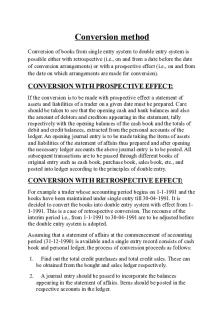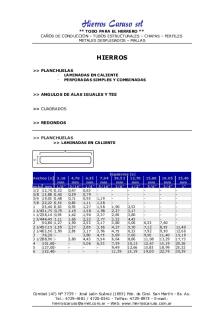Conversion method PDF

| Title | Conversion method |
|---|---|
| Author | Vishnu S Kumar |
| Course | Advanced Financial Accounting I |
| Institution | Madurai Kamaraj University |
| Pages | 4 |
| File Size | 104.4 KB |
| File Type | |
| Total Downloads | 16 |
| Total Views | 182 |
Summary
Lecture note of the Conversion Method from Single Entry to Double Entry System in Financial Accounting....
Description
Conversion method Conversion of books from single entry system to double entry system is possible either with retrospective (i.e., on and from a date before the date of conversion arrangements) or with a prospective effect (i.e., on and from the date on which arrangements are made for conversion).
CONVERSION WITH PROSPECTIVE EFFECT: If the conversion is to be made with prospective effect a statement of assets and liabilities of a trader on a given date must be prepared. Care should be taken to see that the opening cash and bank balances and also the amount of debtors and creditors appearing in the statement, tally respectively with the opening balances of the cash book and the totals of debit and credit balances, extracted from the personal accounts of the ledger. An opening journal entry is to be made taking the items of assets and liabilities of the statement of affairs thus prepared and after opening the necessary ledger accounts the above journal entry is to be posted. All subsequent transactions are to be passed through different books of original entry such as cash book, purchase book, sales book, etc., and posted into ledger according to the principles of double entry.
CONVERSION WITH RETROSPECTIVE EFFECT: For example a trader whose accounting period begins on 1-1-1991 and the books have been maintained under single entry till 30-04-1991. It is decided to convert the books into double entry system with effect from 11-1991. This is a case of retrospective conversion. The recourse of the interim period i.e., from 1-1-1991 to 30-04-1991 are to be adjusted before the double entry system is adopted. Assuming that a statement of affairs at the commencement of accounting period (31-12-1990) is available and a single entry record consists of cash book and personal ledger, the process of conversion proceeds as follows: 1.
Find out the total credit purchases and total credit sales. These can be obtained from the bought and sales ledger respectively.
2.
A journal entry should be passed to incorporate the balances appearing in the statement of affairs. Items should be posted in the respective accounts in the ledger.
3.
The cash book should be scrutinized and post the items of receipts and payments appearing in it in the appropriate accounts in the ledger.
4.
Cash sales and cash purchases can also be found out from the cash book. The figures should be posted to the sales and purchases account respectively.
5. 6.
Post the credit sales and purchases in the ledger. Personal ledger should be scrutinized. Pick up the items for which no corresponding double entry has been effected. These items mostly consist of discount allowed to customers, or discount received, returns inwards, allowances, transfers, bad debts, etc. These items should be posted in the ledger. It is now possible to prepare a trial balance followed by a trading and profit and loss account and balance sheet.
ABRIDGED CONVERSION: There is a way to obtain final results by short cut method. When a summary of cash and other transactions are given; information regarding assets and liabilities in the beginning and at the end of the year is available, the final accounts can be drawn. In such a case, the missing items which may be any of the following are to be found out from the given data:1.
Capital
If capital is unknown prepare the statement of affairs. The difference of assets and liabilities will represent the capital. 2.
Credit purchase
If credit purchases are unknown it can be ascertained from the total creditors account. 3.
Credit sales
If credit sales are unknown, it can be ascertain from the total debtors account. 4.
Bills receivable
I bill receivable are unknown the same may be ascertained from the total debtors account.
5.
Bills payable
If bills payable are unknown the same may be ascertained from total creditors account: 6.
Sundry debtors
7.
Cash in hand and at bank
8.
Stock in the beginning
Sometime opening stock is unknown; if it is unknown it can be calculated from sales. In such a case from sales fin out the cost price of the goods sold. Add in the cost of goods sold the closing stock. Subtract from the result purchases during the year. Any of these items when unknown may be found out preparing a total debtors account and a total creditor’s account. In the absence of complete records, the correct profit and financial position cannot be known. Therefore, a trader may wish to convert the Single Entry system into Double Entry so that he can prepare final accounts, which reveal the exact financial position of the business, apart from knowing the correct profit. The work involved in the conversion of Single Entry into Double Entry will vary with the set of books maintained.
Procedures: The following procedure may be followed for conversion: 1. A Statement of Affairs at the beginning period (at the end of the previous period) should be prepared and open all those assets and liabilities account which have not been already opened. It is possible that some of the items, for the Statement of Affairs, are missing, such as, Debtors or Creditors or Cash-in-hand or any other items at the beginning. If it is so, one has to find them out by preparing ledger accounts. 2. Cash Book should be verified and the un-posted items, from the debit side and credit side of the Cash Book, should be posted to respective accounts, because generally Nominal Accounts and Real Accounts might
not have been opened under Single Entry. Cash balance shown by the Cash Book with Cash-in-hand should be compared. In certain cases, opening balance, closing balance, etc. 3. Impersonal accounts (mainly Sales Account, Purchase Account etc.) must be verified to know the correct figure of sales or purchases. These figures might not have been given in Single Entry. Thus, Credit Sales or Credit Purchases may be found out by preparing Total Debtors Account or Total Creditors Account. 4. Similarly, verify the Cash Book entries relating to discount, allowances, commission etc. to be posted to respective accounts, if not posted already, or open such account if not opened already. 5. Even if no records are kept in respect of certain transactions, such transactions must be journalized and posted. In fact, conversion of Single Entry into Double Entry involves the complete process of journalizing, postings and preparation of Trial Balance. Theoretically, it is possible but practically it is a tedious process and consumes a lot of time. Therefore, one should search out the figures which are needed for the preparation of final accounts. The pieces of information may be scattered in the problem or they may be missing. If such information is missing, it should be got by preparing necessary accounts, before proceeding to prepare final accounts i.e. Trading Account, Profit and Loss Account and Balance Sheet....
Similar Free PDFs

Conversion method
- 4 Pages

Conversion sheet
- 1 Pages

LAB40- Conversion
- 11 Pages

Conversion Factors
- 1 Pages

Conversion Chart
- 1 Pages

Tablas conversion
- 2 Pages

Conversion efficiency
- 2 Pages

Tabla Conversion 129.-192
- 4 Pages

Energy Conversion Lab Sheets
- 27 Pages

Evaluación Conversion DE Angulos
- 2 Pages

Mole conversion Notes KEY
- 3 Pages

Assignment 2 Base Conversion
- 3 Pages

Land conversion - useufl
- 8 Pages

TB-07-Conversion Cycle
- 22 Pages

Signed Binary Decimal Conversion
- 2 Pages
Popular Institutions
- Tinajero National High School - Annex
- Politeknik Caltex Riau
- Yokohama City University
- SGT University
- University of Al-Qadisiyah
- Divine Word College of Vigan
- Techniek College Rotterdam
- Universidade de Santiago
- Universiti Teknologi MARA Cawangan Johor Kampus Pasir Gudang
- Poltekkes Kemenkes Yogyakarta
- Baguio City National High School
- Colegio san marcos
- preparatoria uno
- Centro de Bachillerato Tecnológico Industrial y de Servicios No. 107
- Dalian Maritime University
- Quang Trung Secondary School
- Colegio Tecnológico en Informática
- Corporación Regional de Educación Superior
- Grupo CEDVA
- Dar Al Uloom University
- Centro de Estudios Preuniversitarios de la Universidad Nacional de Ingeniería
- 上智大学
- Aakash International School, Nuna Majara
- San Felipe Neri Catholic School
- Kang Chiao International School - New Taipei City
- Misamis Occidental National High School
- Institución Educativa Escuela Normal Juan Ladrilleros
- Kolehiyo ng Pantukan
- Batanes State College
- Instituto Continental
- Sekolah Menengah Kejuruan Kesehatan Kaltara (Tarakan)
- Colegio de La Inmaculada Concepcion - Cebu
